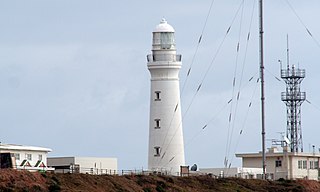
Shimoda is a city and port located in Shizuoka Prefecture, Japan. As of 1 August 2019, the city had an estimated population of 21,402 in 10,787 households, and a population density of 200 persons per km2. The total area of the city is 104.71 square kilometres (40.43 sq mi). In the 1850s, Japan was in political crisis over its increasing inability to maintain its national seclusion policy and the issue of what relations, if any, it should have with foreign powers. For a few years, Shimoda was central to this debate.

Omaesaki Lighthouse is a lighthouse located on a hill at the outermost extremity of Cape Omae south of Omaezaki Port, Shizuoka Prefecture, Japan.

Irōzaki Light is a lighthouse located on a hill at the outermost extremity of Cape Irōzaki south of the town of Minamiizu, Shizuoka Prefecture, Japan on the southernmost extremity of Izu Peninsula. It is located within the borders of the Fuji-Hakone-Izu National Park.

Tsurugisaki Lighthouse is a lighthouse located on Cape Tsurugi on the southeastern extremity of the city of Miura, Kanagawa Prefecture, Japan on the southernmost and eastern tip of Miura Peninsula.

Mizunokojima Lighthouse is an active lighthouse located in Japan's Bungo Channel.

Shiriyazaki Lighthouse is a lighthouse located on the outermost extremity of Cape Shiriyazaki, the northeasternmost point of Honshu, in Higashidōri, Aomori Prefecture, Japan. It received protection as a Registered Tangible Cultural Property in 2017.

Nojimazaki Lighthouse is a lighthouse located at the southern tip of the Bōsō Peninsula, in the city of Minamibōsō, Chiba Prefecture Japan.

Kinkasan Lighthouse is a lighthouse on Kinkasan, an island off the Oshika Peninsula in Ishinomaki, Miyagi, Japan.

Inubōsaki Lighthouse is a lighthouse on Cape Inubō, in the city of Chōshi, Chiba Prefecture Japan. It is notable as one of the few lighthouses whose original lens was a first order Fresnel lens, the strongest type of Fresnel lens. It is a Registered Tangible Cultural Property of Japan. The lighthouse is located within the borders of the Suigo-Tsukuba Quasi-National Park.

Sugashima Lighthouse is a lighthouse located on the island of Sugashima, in Ise Bay off the shores of the city of Toba, Mie Prefecture, Japan. It is located within the borders of the Ise-Shima National Park.

Esaki Lighthouse is a lighthouse located in the city of Awaji, Hyōgo Japan. It is located at the northernmost cape of Awaji Island facing the Akashi Strait opposite the city of Kobe. The lighthouse is located within the borders of the Setonaikai National Park. It is registered with the Japanese government as an “A-grade Lighthouse” for historic preservation and is listed as one of the “50 Lighthouses of Japan” by the Japan Lighthouse Association. It is operated by the Japan Coast Guard.

Kashinozaki Lighthouse is a lighthouse located on the island of Kii Ōshima, off the southwestern coast of Kii Peninsula in the Kansai region of Japan. Administratively, the island is part of the town of Kushimoto, Wakayama Prefecture.

Shionomisaki Lighthouse is a lighthouse located on Cape Shionomisaki,on the southern coast of Kii Peninsula in the Kansai region of Japan. Administratively, it is within the town of Kushimoto, Wakayama Prefecture.

Tomogashima Lighthouse is a lighthouse on the island of Tomogashima in Wakayama, Wakayama, Japan.

Mutsurejima Lighthouse is a lighthouse on the island of Mutsurejima, which is administered by Shimonoseki, Yamaguchi, Japan.

Tsunoshima Lighthouse is a lighthouse on the island of Tsunoshima in the city of Shimonoseki, Yamaguchi Prefecture, Japan. It is notable as being one of only six lighthouses in Japan which had a first order Fresnel lens, the most powerful type of Fresnel lens.

Tsurishima Lighthouse is a lighthouse on the island of Tsurushima, which is administered by Matsuyama, Ehime, Japan.
Eboshijima Lighthouse is an unmanned lighthouse in Eboshijima, a tiny island administered by Itoshima, Fukuoka, Japan. The island is in Karatsu Bay.

Iojimazaki Lighthouse is a lighthouse in Iōjima, Nagasaki, Japan.

The Rokkosaki Lighthouse is a lighthouse located in Suzu, Ishikawa, Japan. Because of its location in the Noroshi neighborhood of Suzu, it is also called the Noroshi Lighthouse. The lighthouse's important cultural history has led it to be named as an A Rank on the "Lighthouse Preservation" list of lighthouses built during the Meiji Period. It has also been selected as one of "Japan's 50 Lighthouse," a survey conducted in 1998 asking respondents around Japan for their favorite lighthouse. In 2017, the lighthouse was selected as a "Lighthouse of Love".





















